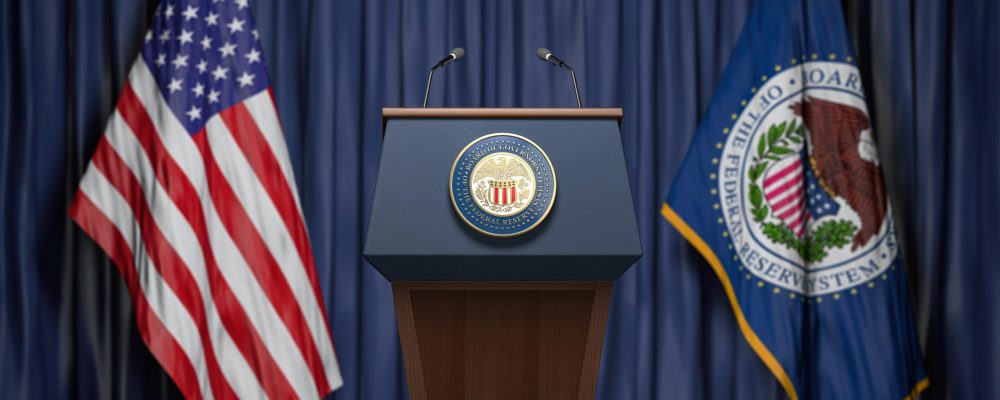
The information provided is based on the published date.
Key takeaways
- Federal Reserve Chair Jerome Powell reiterated the Fed’s previous commitment to bringing down high inflation
- The Fed is trying to achieve this by raising interest rates (which is sometimes also called “tightening policy.)
- U.S. stocks plunged more than 3% that day
- A speech like Powell’s at Jackson Hole doesn’t give us any new information; however, it provides us with clues as to the key indicators and data that the Fed will be watching
- Powell gave us clues to suggest that they will be looking at things like employment growth, job openings, wage growth, and household spending as key indicators
On August 26, Federal Reserve Chair Jerome Powell gave the opening address¹ at the Jackson Hole Economics Symposium. In most respects, this speech was very similar to other remarks he has made recently. However, markets didn’t take it that way, as U.S. stocks plunged more than 3% that day. So what did Powell say to cause such consternation? And what does it mean for investors?
“Without price stability, the economy does not work for anyone”
The Fed has two mandates: price stability and low unemployment. Until recently, we kind of took the price stability side for granted.
Inflation hasn’t been exceptionally high for nearly 40 years. However, within the Fed, they have always believed that price stability was paramount, even over unemployment. There is a belief that high and unstable inflation can actually cause unemployment to rise—a lesson learned from the 1970s.
Specifically, during the Jackson Hole speech, Powell referred to price stability as “the bedrock of our economy” and that without it, “we will not achieve a sustained period of strong labor market conditions that benefit all¹.”
For these reasons, the Fed views the current pace of inflation as unacceptable, and will do whatever it takes to bring it back down.
Note that this messaging is not new from Powell.
At the July Fed meeting, Powell said, “we’re going to be focused on getting inflation back down. And as I’ve said on other occasions, price stability is really the bedrock of the economy. And nothing works in the economy without price stability. We can’t have a strong labor market without price stability for an extended period of time².”
“The unfortunate costs of reducing inflation”
The Chair also discussed the reality that inflation would have some unfortunate side effects.
“Reducing inflation is likely to require a sustained period of below-trend growth” and “higher interest rates, slower growth, and softer labor market conditions will bring down inflation; they will also bring some pain to households and businesses¹.”
Essentially Powell is saying that inflation is a by-product of demand for goods and services outpacing supply (i.e., households want to buy more than is available for sale), and this imbalance is causing prices to rise.
There’s no way to restore balance unless consumer spending slows appears to be the stance being taken. The Fed is trying to achieve this by raising interest rates (which is sometimes also called “tightening policy.”)
Higher interest rates make borrowing more expensive for individuals and businesses. Historically this has tended to lower spending on large ticket items directly, especially housing-related ones.
It should also slow business expansion, since firms typically borrow money to do so. It is also generally true that businesses are less likely to hire additional workers if they aren't expanding.
This is why Powell says higher interest rates will result in slower growth and a softer labor market, but that those things are necessary for inflation to recede.
It isn’t hard to see why the stock market would respond negatively to this news. Weaker economic growth, less consumer spending, and a softer job market are bad news for company profits.
However, Powell isn’t saying anything new here.
At the July FOMC, he said, “We actually think we need a period of growth below potential in order to create some slack so that the supply side can catch up. We also think that there will be, in all likelihood, some softening in labor market conditions… And we think that they’re probably necessary if we were to be able to get inflation back down on a path to 2 percent².”
“We must keep at it until the job is done”
One of the big mistakes the Fed made during the 1970’s inflationary period was easing off on policy too early. In other words, when inflation started to come down, they too often cut interest rates, which reignited inflation. Powell referred to this in his Jackson Hole talk, saying that “the historical record cautions strongly against prematurely loosening policy¹.”
A major reason for this is because, as Powell put it, “the public's expectations about future inflation can play an important role in setting the path of inflation over time¹.”
In other words, there is some psychology to inflation. Right now, most surveys and market trading levels suggest the public expects inflation to return to normal over the next couple of years.
But of course, part of why the public expects this is because the Fed is on the case. People tend to think inflation will be stable over the long run precisely because the Fed’s commitment to price stability is credible.
Powell knows he must guard this credibility at all times.
Last year, the Fed made a mistake when they kept saying inflation would be "transitory." The chairman needs to repair that reputational damage and ensure no other damage occurs while they work to bring inflation down again.
Hence phrases like “our responsibility to deliver price stability is unconditional¹.”
He needs to repeat how committed to low inflation they are. In this regard, the Jackson Hole speech is very much a continuation of a theme.
Again from the July FOMC²: “We are assigned uniquely and unconditionally the obligation of providing price stability to the American people. And we’re going to use our tools to do that.”
“Not a place to stop or pause”
Here is where the Fed’s communications get tricky. Right now, inflation is obviously way too high, so there’s no problem with Powell using very forceful language about fighting inflation.
But at what point should he start talking a bit less forcefully?
Consider that it is generally believed that it takes some time for increased interest rates to impact the economy. The rule of thumb is that it takes 6-12 months for the full effect of a rate hike today to be felt. Because of this, when the Fed hikes, they have to anticipate what the economy will look like in 6-12 months.
Given that, what happens when inflation starts to subside?
Say that the Core PCE, the Fed's favored inflation measure, slows from 4.6% to more like 3.5%. That might signal that interest rates are already high enough and the Fed doesn't need to hike further. If there's already enough downward momentum to inflation, piling on additional hikes might do unnecessary damage to the jobs market.
Powell is perfectly aware of this. In fact, recent data suggests that maybe inflation has already peaked. For example, the July Core PCE release indicated that inflation (as measured by Core PCE) only advanced at a 1.0% annualized rate.
But, of course, it’s only one month, so there is hardly enough evidence to suggest the Fed should back off rate hikes yet. But, if we got 3-4 more months of similar results from Core PCE, the Fed may be singing a different tune.
Powell can’t waffle now. If he did, he would risk damaging that all-important credibility we mentioned above. In other words, if he said anything that even hinted that the Fed could lose its will to keep fighting inflation, that would likely lead to disaster.
For example, what if he suggested the Fed may soon pause rate hikes, and then inflation accelerated again? That kind of reputational damage is untenable.
So what is Powell going to do?
It’s anticipated that he will keep using similar forceful language about inflation and dismiss the possibility of a rate hike pause until the Fed is 100% sure it’s ready.
It will happen suddenly. Behind closed doors, the Fed will be deliberating about the forecast for inflation and the timing of a shift in policy. However, in public, the messaging will continue to be all about fighting inflation.
“The totality of the incoming data”
Given this, we cannot glean much from Fed speeches for a period going forward. A speech like Powell’s at Jackson Hole doesn’t give us any new information. It doesn’t tell us if the Fed is closer or further away from the end of rate hikes.
So what might give us clues about how much more hiking the Fed will do? The answer lies in the data.
Powell even gave us some clues about what kinds of data they were watching. He said they wanted to be "confident that inflation is moving down¹" but did not expressly say that inflation had to be all the way to 2% before ending hikes. So it would seem some lower trend may be enough for a rate hike pause.
He also stated that bringing inflation down would "likely to require a sustained period of below-trend growth" and "some softening of labor market conditions¹." All of this suggests they will be looking at things like employment growth, job openings, wage growth, and household spending as key indicators.
On the data, there’s some good news. As we said above, the most recent inflation reports showed a meaningful deceleration in July. We will have to see if this is the start of a trend. Data on household spending was also weaker in July. Normally we would not want to see weaker spending figures, but under the circumstances, it is a necessary component to bring inflation down.
The jobs picture has been mixed. Job openings have declined meaningfully in recent months. The most recent Job Openings survey indicated a 5% decline from the peak in March of 2022.
This is probably good news for inflation. However, there are mixed signals on actual job growth.
The Bureau of Labor Statistics produces two different job growth surveys. One says that the economy added an average of 437,000 per month between April and July. The other says the average was just 62,000 over that same period.
Overall, we will see how the data develops over the next few months. We plan to be much more focused on this data than Fed speeches. Behind the scenes, we think the Fed will be watching this data as well.
Publicly, it makes perfect sense that the Fed wants to project an aggressive attitude toward fighting inflation. We are sure they are resolute in their will to bring down inflation.
Just don’t take their words too literally. The Fed is liable to change tactics suddenly if the data supports such a shift.
Tom Graff, Chief Investment Officer
Facet Wealth, Inc. (“Facet”) is an SEC registered investment adviser headquartered in Baltimore, Maryland. This is not an offer to sell securities or the solicitation of an offer to purchase securities. This is not investment, financial, legal, or tax advice. Past performance is not a guarantee of future performance.


